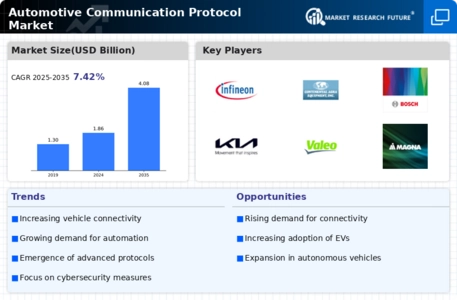Growth of Electric Vehicle Infrastructure
The Automotive Communication Protocol Market is witnessing growth driven by the expansion of electric vehicle (EV) infrastructure. As the adoption of electric vehicles accelerates, the need for efficient communication protocols to support charging infrastructure becomes paramount. The Automotive Communication Protocol Market is projected to reach USD 100 billion by 2025, highlighting the necessity for robust communication systems that facilitate charging station interactions. These protocols are essential for ensuring seamless communication between vehicles and charging stations, thereby enhancing user experience. Consequently, the Automotive Communication Protocol Market is likely to expand as manufacturers develop solutions tailored to the evolving needs of the electric vehicle ecosystem.
Increasing Demand for Vehicle Connectivity
The Automotive Communication Protocol Market is experiencing a surge in demand for enhanced vehicle connectivity. As consumers increasingly seek seamless integration of their devices with vehicles, manufacturers are compelled to adopt advanced communication protocols. This trend is evidenced by the projected growth of the connected car market, which is expected to reach USD 225 billion by 2025. The integration of Internet of Things (IoT) technologies into vehicles necessitates robust communication protocols to ensure reliable data exchange. Consequently, automotive manufacturers are investing in the development of sophisticated communication systems to meet consumer expectations, thereby driving the Automotive Communication Protocol Market.
Advancements in Vehicle Safety Technologies
The Automotive Communication Protocol Market is significantly influenced by advancements in vehicle safety technologies. The implementation of protocols that support Advanced Driver Assistance Systems (ADAS) is becoming increasingly critical. For instance, the market for ADAS is anticipated to grow at a compound annual growth rate (CAGR) of 10.5% from 2020 to 2027. This growth is largely attributed to the rising emphasis on safety regulations and the need for enhanced vehicle performance. As manufacturers strive to comply with stringent safety standards, the demand for effective communication protocols that facilitate real-time data sharing among vehicle systems is likely to escalate, thereby propelling the Automotive Communication Protocol Market.
Emergence of Smart Transportation Solutions
The Automotive Communication Protocol Market is being propelled by the emergence of smart transportation solutions. As urbanization continues to rise, cities are increasingly adopting intelligent transportation systems (ITS) to improve traffic management and reduce congestion. The Automotive Communication Protocol Market is projected to reach USD 220 billion by 2025, indicating a robust demand for communication protocols that enable vehicle-to-everything (V2X) communication. These protocols are essential for facilitating interactions between vehicles, infrastructure, and pedestrians, thereby enhancing overall road safety and efficiency. Consequently, the Automotive Communication Protocol Market is likely to benefit from the growing integration of smart technologies in transportation.
Regulatory Compliance and Standardization Efforts
The Automotive Communication Protocol Market is significantly shaped by regulatory compliance and standardization efforts. Governments and regulatory bodies are increasingly mandating the adoption of standardized communication protocols to ensure interoperability among various vehicle systems. For example, the ISO 26262 standard for functional safety in automotive systems is gaining traction. This standardization is crucial for manufacturers aiming to enhance safety and reliability in their vehicles. As a result, the demand for compliant communication protocols is expected to rise, driving growth in the Automotive Communication Protocol Market. Manufacturers are likely to invest in developing solutions that align with these regulatory requirements.

















Leave a Comment